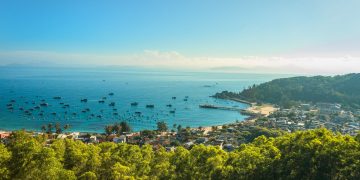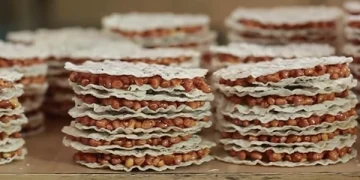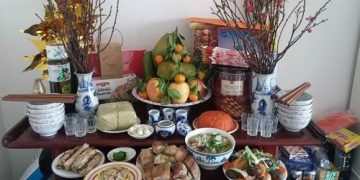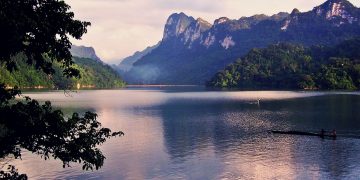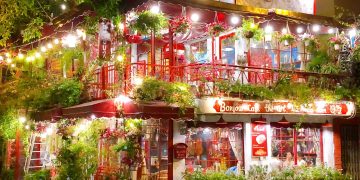Hue Citadel is also known as Thuan Hoa Citadel. This complex was the capital of the Nguyen Dynasty for 140 years. Although the Nguyen dynasties have declined, Hue Citadel still retains the quintessence of ancient architecture and is also the most popular tourist destination attracting many visitors. Let’s follow Say Hello Vietnam to discover!
Contents
A brief overview of Hue Citadel
Location: Located on the north bank of the Perfume River, in Hue city, Thua Thien Hue province.
Discovering the dreamy land of Hue, visitors do not forget to stop by to visit Hue Citadel – one of the historical proofs of the country’s golden age during the feudal period.



Few things tourists need to know when visiting Hue Citadel
Opening hours
Hue Citadel will be open to visitors every day from 7 am to 5 pm. You should pay attention to the time to arrange the schedule appropriately and fully conquer the scenic spots in this relic.
Ticket price
To enter Hue Imperial City, visitors need to buy entrance tickets. You can refer to the ticket price as follows:
– Adults: 150,000 VND / time
– Children from 6 to 12 years old: 30,000 VND/time
Instructions on how to move to Hue Citadel
To get to Hue Citadel, visitors first need to reach Hue city. Due to the development of transport infrastructure, you can move to the ancient capital by many means such as motorbikes, coaches, trains, planes. After visitors reach Hue city, you can rent a motorbike or choose a reputable taxi to move across Phu Xuan bridge and run through Cua Ban. Then you will get Hue Citadel.
Costumes when visiting Hue Citadel
Because you have to move a lot in the Hue Citadel, you should choose comfortable clothes for easy movement, avoid wearing high heels because your feet will hurt. In addition, The Citadel is also a historical relic with many mausoleums, pagodas, and communal houses, so visitors should choose discreet clothes and avoid revealing and offensive.

The History
In 1802, right after reunifying the country and ascending the throne, King Gia Long – the first king of the Nguyen Dynasty, decided to choose Hue to build the Hue Citadel. Because people only traveled by elephants and horses at that time, the king thought that the capital must be located between the two ends of the country to facilitate the exchange of information. After that, people planned the Citadel, and construction began in 1805. King Gia Long and the ministers of the Nguyen Dynasty took care of the entire field survey process.





Some villages have been erased, and some rivers flow through Hue, only remaining in names in history books. Looking back today, few people would think that Hue had changed, such as: filling rivers, digging trenches, filling holes, digging canals, but thinking that Hue Citadel was built on such available land.
Read more:
- 5 Tombs of the Nguyen Dynasty you should visit
- An Dinh Palace, discover the golden age of the Nguyen Dynasty
- Hue in silence
Design of Hue Citadel
The architecture
Hue Citadel is square, 11km in circumference, and 520ha in area. You know, to have such a large piece of land, in the past, the king had to order the relocation of 8 villages in this area to build the capital, including Phu Xuan, Van Xuan, Dien Phai, An Van, An Hoa, An My, The Lai, An Buu. And then compensate them eight new lands to rebuild the village.


Thanks to the clever application to suit the terrain, Hue Citadel becomes one of the unique architectural works, with changes and differences compared to the previous capitals.
How many gates does Hue Citadel have?
There are 13 gates in all, of which ten will lead to the outside, one internal gate, and two waterway gates.
Which ten main gates of Hue Citadel include:












The relics in Hue Citadel
Forbidden City
The Forbidden City is the innermost Citadel of Hue Citadel. This place was built in 1804 for the king and royal family.

Inside the Citadel, there are nearly 50 large and small works such as Thuong Thien (the cooking place for the king), Can Chanh Palace, Can Thanh Palace.







Imperial Citadel (Citadel)
The Imperial Citadel ( Citadel ) is the second Citadel of Hue Citadel, designed as the king’s residence and the royal family and the workplace of the feudal court. This palace is also a place to worship ancestors and the late Nguyen kings.
The Imperial Citadel has more than 100 works built-in 1804 under King Gia Long and completed in 1833 under King Minh Mang. In addition, inside the Imperial Citadel, there is Dien Tho Palace, Hien Lam Cac.



Thai Hoa Palace – The symbol of the power of the Nguyen Dynasty
In the journey to discover Hue Citadel, Thai Hoa Palace attracts many visitors when witnessing the coronation of Nguyen Dynasty kings, sitting on the throne to rule the country.





Ngo Mon is the main gate, located at the South gate of Hue Citadel. This gate is the entrance of the Nguyen Dynasty or the place where important ceremonies are held.
Together with the system of palaces inside, Ngo Mon Gate forms a magnificent and magnificent architectural work.



Besides, Hue Citadel also has several other monuments such as Ngu Phung Lau, Ky Dai, Quoc Tu Giam School, Long An Palace, Bao Vinh Ancient Town. With ancient beauty, splendor, majesty, the Imperial City Hue is an attractive tourist place, attracting many visitors to move to this land of God.



